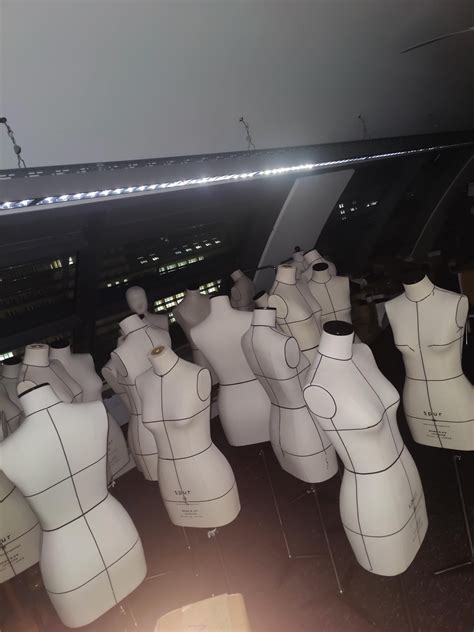Introduction

Mannequins, those ubiquitous fixtures of retail stores, often go unnoticed amidst the vibrant displays and bustling shoppers. But behind the scenes, in vast warehouses and storage facilities, lies a hidden treasure—a vast army of 14,000 mannequins, each with its own unique story to tell.
The Anatomy of Mannequin Storage
The storage of mannequins is a highly specialized operation, requiring meticulous attention to detail and a deep understanding of their delicate anatomy. Mannequins are typically constructed from lightweight materials such as fiberglass, plastic, or wood, and they can be fragile and easily damaged if not handled properly.
To ensure the longevity of these valuable assets, storage facilities implement a strict set of protocols. Mannequins are meticulously cleaned and inspected before being placed in storage, and they are carefully packed and stacked to minimize the risk of damage.
A Universe of Mannequin Types
The world of mannequins is as diverse as the retail industry itself. From the classic female form to the abstract wireframe, mannequins come in a bewildering array of shapes, sizes, and materials.
Each type of mannequin serves a specific purpose. Full-body mannequins are used to showcase clothing and accessories, while half-body mannequins are ideal for displaying tops, skirts, or pants. Poseable mannequins allow retailers to create dynamic and engaging displays, while headless mannequins provide a minimalist backdrop for highlighting accessories.
The Economic Impact of Mannequin Storage
The storage of mannequins is a significant expense for retailers, but it is an investment that pays dividends in the long run. By protecting mannequins from damage and deterioration, storage facilities help retailers extend the lifespan of their assets and reduce the need for costly replacements.
According to industry estimates, the average lifespan of a mannequin is 3-5 years. However, with proper storage and maintenance, mannequins can last for 10 years or more. This significant increase in lifespan translates to substantial savings for retailers.
Emerging Technologies in Mannequin Storage
The advent of new technologies is transforming the way mannequins are stored and managed. RFID (radio frequency identification) tags are now being attached to mannequins, allowing retailers to track their inventory in real-time and reduce the risk of loss or theft.
Artificial intelligence (AI) is also making its way into the mannequin storage sector. AI-powered systems can analyze data from RFID tags and other sensors to identify patterns and trends in mannequin usage. This information can help retailers optimize their storage practices and reduce costs.
The Creative Potential of Mannequin Storage
Beyond their primary function as display fixtures, mannequins also hold a wealth of creative potential. Artists and designers have found innovative ways to repurpose mannequins into unique works of art and design objects.
From mannequin-based installations to fashion sculptures, the creative possibilities are endless. Mannequins can be used to explore themes of identity, consumerism, and the human form.
Conclusion
The hidden world of mannequin storage is a fascinating microcosm of the retail industry. From the meticulous care taken in their preservation to their potential as creative muses, mannequins play a vital role in shaping the shopping experience.
As the retail landscape continues to evolve, so too will the role of mannequins in storage. New technologies and creative applications will unlock the full potential of these versatile and enigmatic objects.
Key Stats and Facts
- The global mannequin market was valued at $1.8 billion in 2022 and is projected to reach $2.5 billion by 2030.
- The average lifespan of a mannequin is 3-5 years, but with proper storage and maintenance, it can last for 10 years or more.
- RFID tags are being increasingly used to track mannequin inventory and reduce the risk of loss or theft.
- AI-powered systems are helping retailers optimize their mannequin storage practices and reduce costs.
Useful Tables
| Mannequin Type | Purpose |
|---|---|
| Full-body | Showcase clothing and accessories |
| Half-body | Display tops, skirts, or pants |
| Poseable | Create dynamic and engaging displays |
| Headless | Highlight accessories |
| Material | Advantages | Disadvantages |
|---|---|---|
| Fiberglass | Lightweight and durable | Can be brittle |
| Plastic | Lightweight and affordable | Can fade or become scratched |
| Wood | Sturdy and natural-looking | Heavy and expensive |
| Storage Method | Advantages | Disadvantages |
|---|---|---|
| Stacking | Space-efficient | Can damage mannequins if not done properly |
| Hanging | Preserves mannequin shape | Requires specialized equipment |
| Crating | Protects mannequins from damage | Bulky and time-consuming |
| Emerging Technology | Advantages | Disadvantages |
|---|---|---|
| RFID tags | Real-time inventory tracking | Can be expensive |
| AI-powered systems | Optimize storage practices | Require specialized expertise |
